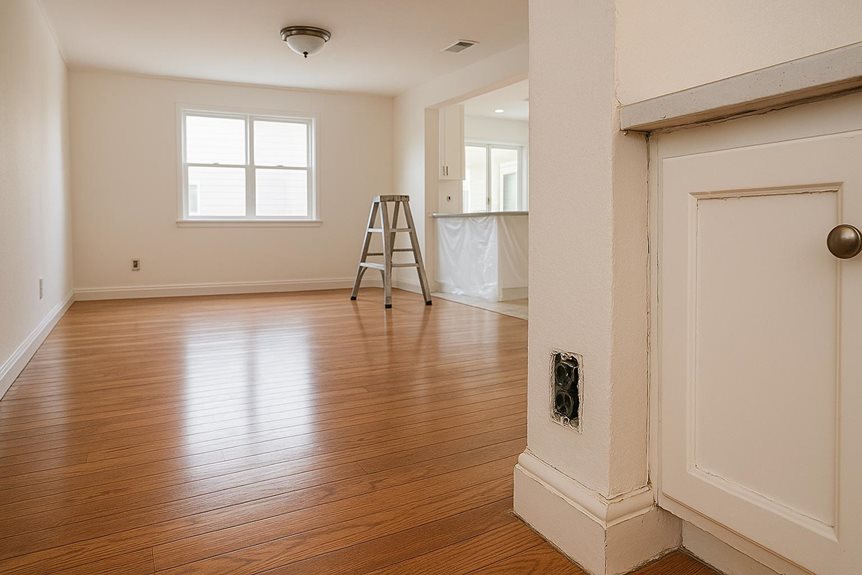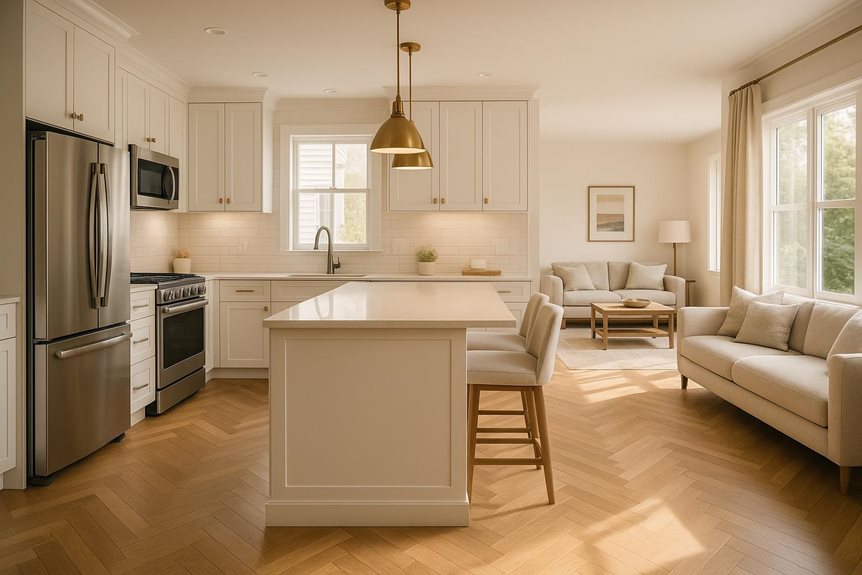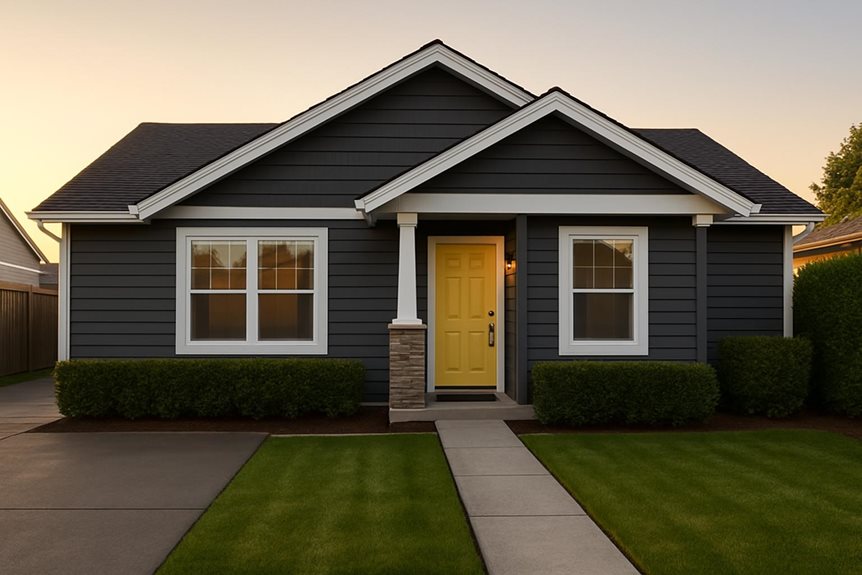When you buy a recently renovated home, don’t just admire the finish. Look behind the walls for proper water drainage, updated wiring, and any signs of moisture or rot. Check electrical safety: panel labeling, breakers that trip, GFCI outlets, and safe outlets and boxes. Inspect plumbing for adequate pressure, quick drainage, and correct pipe sizing. Verify permits, plans, and inspections were completed. If you keep asking these questions, you’ll uncover risks and learn more today.

Key Takeaways
- Hidden water issues: look behind renovated areas for moisture, stains, or mustiness signaling leaks or rot.
- Electrical safety: verify panel labeling, functioning breakers, proper grounding, GFCIs, and no exposed wiring.
- Structural integrity: check for uneven floors, large cracks, and misaligned doors indicating framing or foundation problems.
- Plumbing and HVAC: test water pressure, drainage, pipe materials, and verify ducts and insulation are correct.
- Permits and documentation: ensure permits, inspections, and as-built plans exist for all major renovations.
Hidden Problems to Inspect in Renovation Areas
Hidden problems can lurk behind renovation work, so it’s essential to inspect beyond the visible finishes. Always verify proper water drainage in the area, because poor water drainage can undermine renovations. Start by looking behind walls for painted-over outlets, mismatched breaker boxes, and any exposed live wires that aren’t properly capped or labeled.
Check for uneven floors, large cracks, and doors that don’t sit squarely, as these can signal foundation movement or framing issues. In damp spaces, sniff for mustiness and note stains on wood beams or hidden areas beneath finishes, which hint at hidden moisture or rot. Look at windows and doors for faulty seals, cracked caulk, and rotted frames that undermine efficiency and safety. Finally, assess insulation and ductwork for gaps, improper venting, or over heated panels that reduce performance. Ask a pro to confirm findings later.
Quality of Workmanship Across Key Systems

Quality home renovation workmanship across key systems means you start by confirming each major system is installed correctly and performs as intended, not just looks right.
Additionally, verify electrical safety by testing all switches and outlets, and ensure there are no signs of overheating or exposed wiring in wet areas.
In HVAC sector, check ductwork for kinks or excessive coiled flexible runs, verify ducts in unconditioned spaces are insulated to at least R-6, and verify bedroom pressure balancing with transfer grills or dedicated returns.
For plumbing, confirm pipes are secure and protected, outdoor faucets operate, water tanks are safely mounted, hot and cold taps aren’t transposed, and the dishwasher drains properly with no leaks. Inspect flooring and surfaces for flatness, smooth finishes, and solid grout or sealant.
Windows and doors should open freely, hardware work, locks function, and door thresholds sit level. Interior trim should be tight, clean, and finished.
Electrical Safety and Compliance Checks
After you’ve reviewed the workmanship across major systems, you’ll want to turn your attention to electrical safety and code compliance, because the electrical backbone of a renovated home affects every other function you rely on. Be aware that older homes may have outdated panels, which can pose serious safety risks.
Check the electrical panel for labeling, labeling clearly, no overheating, corrosion, or outdated components, and verify that all breakers trip and reset. Confirm voltage and amperage tests meet specs, and that panel fits flush per code, properly. Confirm GFCI outlets are installed in areas, test monthly, and replace units immediately as required.
Inspect outlets and switches for snug fits, proper grounding, and intact faceplates; address any damage or wear near water sources. Verify wiring is intact, cables anchored, and there’s enough box space, with permits and rough-ins in order.
Plumbing Performance and Water Temperature

When you’re evaluating plumbing in a renovated home, start by checking for adequate pipe sizing and consistent water pressure, since undersized pipes or mis-sized fittings can throttle flow and cause backups. You’ll want to test multiple fixtures for steady spray and quick drainage, noting any slow drains or pressure drops that hint at hidden sizing or corrosion issues.
Be aware that PVC, CPVC, or PEX pipes may have size labels, but unlabeled runs require diameter measurement and conversion charts to confirm correct sizing. Temperature consistency matters too: guarantee hot water reaches baths and showers promptly, and watch for temperature fluctuations that signal past pipe deterioration or mixing with incompatible materials. Address calcium buildup and aging fixtures before full substitution for safer long-term home performance.
Also, always have a qualified plumber verify pipe sizing and fittings to prevent pressure drops.
Permit, Codes, and Documentation to Review
Permits, codes, and documentation set the foundation for a safe, compliant renovation, so start by confirming you have the right approvals before any work begins. Obtaining permits is crucial before starting any home renovations to ensure compliance with local building codes and regulations permits.
Major projects require building permits for new structures, additions, or substantial demolitions, and electrical, plumbing, gas/mechanical, and swimming pool permits where applicable.
Confirm the permit application includes a detailed scope of work, floor plans, and construction drawings, plus warranty deed copies and government-issued ID. You’ll also need proof of insurance.
After approval, expect mandatory inspections; trade permits must be pulled for electrical, plumbing, and gas work, and the final certificate of occupancy may be required. Municipal records, zoning rules, and after-hours approvals influence usability, so verify records with the local department and keep plans accessible for quick reference later.
No Comments
Be the first to start a conversation